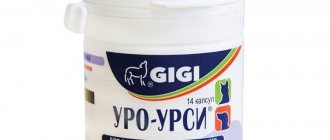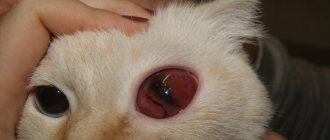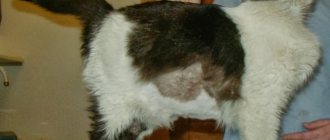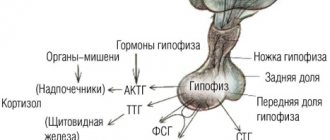Symptoms of cystitis:
- Problems with urination. Due to inflammation, the cat has a constant feeling of fullness in the bladder. She begins to often sit down on the tray (possibly in other places) and intensively lick the genitals. In this case, urine is released literally drop by drop, or even completely absent;
- Thirst;
- Painful urination. At the end of the act, the cat may even make plaintive sounds;
- Change in the color of urine, the appearance of blood or pus in it;
- The specific smell of urine is sharp ammonia or purulent;
- Depressed state, lethargy, refusal to feed, increase and then decrease in temperature, vomiting - against the background of the development of intoxication (poisoning of the body).
Questions for a veterinarian therapist
Only, IMHO, it stinks and clogs with old age. How old is the cat? Maybe, really, see a doctor. If you need to clean the “around the butt,” it’s better to do it skillfully.
she is 2.5 years old. and it feels like she is emitting gases either from tenderness: unsure: , or from fear (well, you never know, what is she afraid of?: blinking: ) but how am I going to tell the doctor?: blinking:
Just tell it like it is. They are doctors, they are no strangers to confused stories from frightened animal owners
For a pet owner, the health of his pet is always very important. Unfortunately, four-legged friends cannot report a problem, and we only have to guess based on external signs.
You should not treat your pet on your own - contact a specialist. Graduates of the veterinary academy have both skills and knowledge, unlike you. A common pathology among cats is damage to the reproductive system. Diseases are observed in very different periods:
- during pregnancy;
- after childbirth;
- in a sterile condition.
You can understand about uterine pathology by external signs - cats are worried, their appetite decreases, and bald spots form on their sides. But the most sure sign is a cat’s discharge. Discharge from the genital slit can be abundant or scanty, transparent or cloudy, liquid or thick, white or colored. The classification includes dozens of types of discharge; brown discharge in cats during pregnancy is a common occurrence. A cat who has not given birth is characterized by the presence of clear, scanty, odorless discharge. Usually the owners do not notice them - the pets are very clean and constantly lick themselves. But not everything is always limited to physiological effects. In a cat, you can often find dried brown crusts, or small discharges of a bloody or dark burgundy color. They are opaque, quite thick with a small impurity. Most often, this type of discharge indicates pathologies in the uterus, but a positive outcome is also possible.
Causes of cystitis
- Hypothermia of the animal, for example, the cat staying in a draft for a long time, under an open window, on a cold floor or windowsill
- Inflammatory processes in organs close to the bladder
- Complication of other diseases of the genitourinary system: pyelonephritis (inflammatory kidney disease of predominantly bacterial nature), urolithiasis or damage to the urinary organs by parasites
- Mechanical damage to the urethra
- Poor circulation due to injury
- Improper feeding of a cat - unbalanced natural diet, dry food with low water consumption or overeating, leading to obesity and an increase in the concentration of salts in the urine. As a result, the kidneys cannot cope with the filtration and elimination of toxins, swelling of the urethra occurs and the outflow of urine is impaired - a sediment of salts and mucus is formed, the urethra is blocked, urolithiasis develops, and cystitis becomes chronic.
- Low activity of the pet, physical inactivity, which slows down the metabolism.
- Parasites (helminths (worms), fleas, ticks, lice eaters) that contribute to mechanical damage to the external genitalia. Since the anus is located next to the urethra, when the cat licks itself, the infection spreads to the bladder. In addition, parasites secrete toxins that disrupt metabolism and cause secondary cystitis.
- Bacterial and viral infections (including those acquired through mother's milk or introduced during mating). Cystitis can be caused by diseases of viral etiology, which can be prevented with annual vaccination - calicivirus, rhinotracheitis and chlamydia. Each of them is chronic and has a carrier form. This form without clinical signs is one of the causes of cystitis. Treatment of cystitis in this case does not give results: as soon as it stops, cystitis returns.
- A state of anxiety or stress in a cat.
- Idiopathic cystitis (IC) - cystitis with no apparent cause - a situation where clinical signs (frequent, painful urination, blood in the urine, etc.), confirmed by tests, are present without identifying any clear reasons for the development of the disease (bacterial infection, urolithiasis, etc.). IC is more often observed in overweight cats that do not leave the house.
Vanya cat.
There are no unimportant diseases
There is a widespread opinion that if a cat “rides” on its butt, then it is probably tormented by worms. True, this isn’t about your beloved and beloved pet, is it? You do not forget about regular anthelmintic measures (tablets, sweet suspensions or drops on the withers), as well as vaccinations against infections and treatment for fleas and other “bloodsuckers”. Then what is the reason? And the reason for such unusual and even unworthy behavior of your noble/high-ranking pet is that his anal glands (sinuses) are probably inflamed.
Having learned about this diagnosis (or rather diagnoses: paraproctitis, paraanal sinusitis), most visitors to veterinary clinics exclaim: what kind of misfortune is this? Well, first of all, the problem is not in the mouth, but precisely on the opposite part of the digestive tract.
The fact is that in the immediate vicinity of the anus (anus) in most mammals, the ducts of the paraanal glands open (para - from the Latin about, and anal - anal). These are small holes (as if pierced with a needle) located on the sides of the anus (they can be seen if you slightly open the anus). Normally, the secretion of these glands is constantly released during the act of defecation. However, in the case:
non-compliance with basic hygiene rules (accumulation of feces under the tail),
physical inactivity (coupled with obesity) and/or
unbalanced nutrition, leading to too soft or even loose stools,
these glands become inflamed, the secretion begins to accumulate in the capsule (cavity) of the gland and causes unpleasant pain in the animal. It is the release of a large amount of disgusting mass, both in appearance and smell, when pressing under the cat’s tail that is the main diagnostic sign of this disease.
In addition, inflammation very quickly spreads to the tissue surrounding the anus (even blood poisoning may eventually develop). Cats begin to intensively lick under their tails, ride on their butts, become restless or even aggressive.
If adequate measures are not taken in time and the ducts and capsule of the gland are not cleaned or washed, intense bacterial inflammation occurs and pus breaks out in the perineal area. It looks like a terrible ulcer (the skin in this area is thin and breaks easily) and, of course, requires immediate surgical intervention (and a decent amount of money, of course). Sometimes the matter can even result in partial loss of innervation of the hind limbs (paraparesis) and/or release of purulent contents into the abdominal cavity. Therefore, put your hands on your feet, put the cat in the carrier and run to the doctor.
Treatment or one in the field is not a warrior!
Treatment of paraanal problems is possible only in a veterinary clinic. If the disease is very advanced, then general anesthesia may even be required. In any case, no cat with a sound mind and strong memory will allow all the necessary procedures to be carried out on her without a fight. And in order to carry out complex treatment (especially during the initial treatment), it is necessary:
-correctly, firmly, securely fix the animal on the table (to avoid bloodshed, and in general for the possibility of treatment) and move the tail back as much as possible (one cat requires at least two people with secondary or higher veterinary education);
-squeeze out the purulent contents of the glands and rinse them through the catheter with an antiseptic solution (this is practically a jeweler’s work, since the cat is a small animal, and even an experienced doctor may not find the ducts of the required glands right away, and this... plus one more person for the same cat);
-and finally, inject the affected area with antibiotics and insert an anti-inflammatory suppository (or an ointment similar in effect) into the anus;
All this time, most of the cats scream heart-rendingly at the top of their lungs (and sometimes completely incommensurate with the pain they experience), and try to escape from the hands of the “torturers.” The spectacle, frankly speaking, is not for the faint of heart.
Prevention is the key to success
The area around the tail requires the same constant care as the eyes and ears (hygiene is the key to health, equally for all parts of the body). Moreover, there is nothing complicated in the specific prevention of paraproctitis. Regular (once a week, for example) squeezing the sinuses will almost certainly save your patient (and you, of course) from a lot of trouble. It is best to ask your doctor about how you can do this yourself (in technical and practical terms). One or two practical lessons and paraproctitis will forever forget the way to your home.
What are they needed for
Anal (paraanal) glands are special derivatives of sweat and sebaceous glands, the odorous, fetid (to the human nose, of course) secretion serves for communicative functions (marking territory or attracting individuals of the opposite sex, for example). The secretion of these glands also serves to scare away enemies (skunks are world famous thanks to these glands). The secretion of the paraanal sinuses not only has a completely unique smell, but is also much more durable than the most expensive perfume delights. Therefore, getting this natural “flavor” on clothes or furniture is extremely undesirable.
Roman Leonard, chief physician of the clinic.
Site Administrator | 03/14/2016
Maria Osipovna is ready to strangle her own unwashed cat. He stinks so much of urine that it stops him from breathing. What should an old lady do? Put the poor guy to sleep or grow wiser?
For God's sake, forgive me, dear readers.
Features of cystitis
Both male and female cats are susceptible to cystitis. But clinical manifestations in cats are much more common. This is due to anatomical features. In cats, the urethra is straight, short and wide, so salt crystals are excreted almost unhindered in the urine. In cats, the urethra is longer, has bends and narrowings, so mucus and salt plugs often appear in it, completely blocking the flow of urine (obstruction).
Neutered cats, whose genitourinary system functions differently than normal cats, are more prone to cystitis. In addition, stagnation of blood in the genitals leads to swelling, and this leads to spasms and urinary retention, stagnation in the bladder, salt loss, urolithiasis and chronic cystitis.
Sometimes, with cystitis, pets avoid using their litter box because they associate it with pain when urinating. And in some cases, the fear of the toilet remains even after complete recovery. Thus, cystitis can cause behavioral changes.
What kind of discharge does a cat have?
The first group of discharge is associated with the cat’s pregnancy and impending birth. If the cat is pregnant, then the presence of ichor is normal. Also, discharge appears when a cat comes into heat. Liquid flows from under the tail; it is a white or brown discharge. They will be accompanied by changes in behavior: meowing loudly, arching his back and taking a position for intercourse. The animal shows strong affection towards its owners. They have a translucent consistency, odorless and colorless.
Uterine infections in cats
In appearance, the discharge may have other signs:
- Color;
- Consistency;
- Presence and absence of odor;
- Abundance of discharge;
It is by these signs that the owner and veterinarian recognize the true cause and nature of the discharge, and also prescribe treatment. The frequency of discharge and its quantity are of great importance.
Note! Some mucus and pus may come out of the eyes as tears.
Why is cystitis dangerous?
thickening of the walls of the bladder with chronic cystitis.
Cystitis can be acute or chronic . Without measures, acute cystitis becomes chronic, which is difficult to treat. Chronic cystitis is more common in older animals, and its main symptom is the presence of blood in the bladder. With chronic cystitis, changes occur in the walls of the bladder, hypertrophy of the muscle layer develops, that is, the bladder does not empty completely. As a result, an infection accumulates, which manifests itself as another attack of cystitis.
In advanced cases, cystitis is complicated by the development of purulent processes. Inflammation from the bladder rises to the kidneys, causing their disease (pyelitis), provokes the formation of salt stones, and the development of paresis or paralysis of the bladder. In severe cases, the inflammatory process spreads into the abdominal cavity, causing peritonitis.
With obstruction (blockage) of the urethra, internal pressure in the bladder, ureter and renal pelvis increases, this leads to kidney blockage - a complete cessation of urine output. The animal's condition quickly deteriorates due to the development of intoxication (lethargy, apathy, vomiting and a specific smell of exhaled air). Part of the function of the kidneys in removing toxic products can be taken over by the skin, lungs, and digestive organs - in this way the body tries to reduce the concentration of toxins and save life. Without emergency veterinary care, urethral obstruction in cats can be fatal within 24-48 hours.
How to treat pathology?
When brown, pink or white discharge appears in a cat due to natural causes, no special treatment is prescribed. If the owner does not intend to breed offspring, it is better to sterilize the pet. In a castrated cat, such problems disappear on their own. It’s another matter when blood flows from the genitals due to the progression of a dangerous disease. A treatment regimen that includes the following groups of drugs will help stop the disease:
An examination will help to cope with the situation, on the basis of which drug treatment will be prescribed.
- Hemostatic. Prescribed only by a doctor, they are used in cases where bleeding occurs without stopping due to a violation of the hematopoietic process.
- Antibiotics. They are used when there is pus with pathological ichor in the vaginal discharge, which indicates the addition of a bacterial infection.
Sometimes, with heavy bleeding, conservative therapy is powerless. Then the doctor decides to treat the pathology surgically. During surgery, defects that bleed are eliminated, as well as affected internal organs, including the uterus, are removed. After the operation, rehabilitation is carried out. Fluid may still be released from the genitals, so the animal must be under the supervision of a doctor who strictly monitors how recovery is progressing.
Diagnosis of cystitis
When the first signs of the disease appear, you should contact a veterinary clinic. To confirm the diagnosis you will need:
- urine test result. Depending on the severity of the inflammatory process, protein, mucus, leukocytes, red blood cells, epithelium, pus, blood, and salt crystals may be present in the urine. The laboratory must also conduct a bacteriological study (bacterial culture) to isolate pathogenic microflora (cocci, streptococci, Escherichia coli, Pseudomonas aeruginosa, etc.) and determine the reaction to sensitivity to antibiotics
- cystoscopy - examination of the bladder using a special device
- ultrasonography
- clinical and biochemical blood tests, which may indicate kidney problems and other abnormalities
- Possible smear test for genital tract infections
What to do if you notice brown discharge?
Independent knowledge, as a rule, is not enough here - consultation with a veterinarian is required. The owner can independently assess the viability of the fruit:
- when the cat is at rest, look at the belly - the kittens should move;
- palpate the abdominal cavity - you can assess the contents of the uterus.
Even after making sure that the kittens are viable, you should contact a veterinarian, because the presence of leaks may indicate serious problems:
- partial abortion, when part of the fetus dies;
- vaginitis;
- damage to the urinary system.
There are several methods for diagnosing a cat during pregnancy. The most effective is ultrasound examination. The specialist will determine the viability of all fruits and identify the presence of pathologies. But you can resort to other measures:
- bimanual palpation;
- vaginal smear cytology – exclusion of vaginitis;
- clinical blood test;
- blood test for inflammatory mediators - ASAT, ALAT.
If a hidden abortion or the death of some fetuses is detected, the doctor often prescribes uterine stimulants to expel the contents. Afterwards there is a long course of recovery using antibiotics, vitamins, and immunostimulants. Vaginitis usually does not become a serious problem, but an ascending infection is possible when the process spreads to the uterus. Therefore, you should also take antibiotics; it is recommended to use drugs that do not cross the placental barrier. >Causes of inflammation and methods of treating paraanal glands in cats
Treatment of cystitis
When the first signs of cystitis appear, you should provide the animal with peace and warmth; you can warm the stomach with a heating pad. It is necessary (!) to remove food from the cat, which will help stop the increase in urine concentration and reduce the load on the kidneys to eliminate metabolic products. It is also important to increase the amount you drink, as the liquid “flushes” the bladder. For cystitis, diuretics are also very useful - decoctions of lingonberry leaves, half-palm, etc. (only if there is no blockage of the urinary canal!)
Treatment is prescribed by a veterinarian depending on the complexity of the disease. For acute bacterial cystitis, long-term antibiotics are prescribed. In severe cases, it is possible to wash the bladder with a solution of potassium permanganate, furatsilin, etc. Usually, for cystitis, diuretics, homeopathy (Kantaren), Cat Erwin, vitamins and immunocorrectors are prescribed. If urination is painful, painkillers may be prescribed, and if infectious complications occur, sulfa drugs used to treat urinary tract infections.
If cystitis in a cat is a consequence of another disease of the genitourinary system, then this disease should be treated first.
In any case, you should not self-medicate cystitis; this can harm the animal.
After treatment, a repeat urine test is necessary to ensure there is no infection.
The cat smells bad and another problem...
But I keep my promises and answer even such absurd questions.
We all stink sooner or later. This is me already turning to you, dear old lady.
We will stink from old age, or rather from illness. Urinating on itself, your cat, who lived with an unbearable owner for about 11 years, began to slowly “give up.”
Are you maliciously demanding useful advice from me? I give you as much as 10 so that it will last you for the rest of your life.
* You personally don’t have to do anything - you’ll only cause harm.
Your cat smells like urine - very pungent and specific.
Take the carrier and place the cat, having previously made an appointment at the veterinary clinic.
There they will tell you why you are suffocating from the stench.
* By mercilessly chasing the cat, it will stink even more, “dropping” urine in the wrong place.
Cats, you know, are vengeful animals.
* After visiting the veterinarian, treat the animal immediately. If you trust a doctor who associates the stench with a serious and incurable disease of the internal organs (for example, extensive kidney damage from multiple cystic formations), you will be offered to euthanize the cat, and not strangle it, as you wish.
* Even after the poor animal is gone, the stench of urine will linger in a lonely apartment for a long time.
* I’m not an expert in cleaning rooms, but it clearly requires not superficial sanitization, but thorough one, so that the smell of urine gradually disappears.
* It is possible that you will have to throw away some particularly absorbent furniture.
* We all hope that things won’t come to the point of euthanasia, and you will have to get rid of the stench with medications.
As a rule, these are tablets and a series of injections. Therefore, gather your last strength to take the full course prescribed by your veterinarian.
* Unclean cats, who are not initially accustomed to pooping, urinate wherever they want, stinking so much that the neighbors are banging on the wall.
* In advanced cases, it is not possible to correct the animal’s behavior. Too much time wasted.
* Maria Osipovna, I don’t tell you as a reproach.
I recently watched a program where a lonely elderly woman kept more than a dozen cats in her apartment, which meowed heart-rendingly, disturbing the peace of those living nearby.
There was no mention of urea.
Either the cats are too well-groomed, or she doesn’t play football with them, like you, her only one.
The material was prepared by me, Edwin Vostryakovsky.
Share the page on social networks
leave a comment
Pet club forums > Talk about animals > Cats, cats, kittens... > Skunk cat?
View full version : Skunk cat?
horror. just a nightmare. suddenly, out of the blue, our kitty can release SUCH an aroma from her “organs” that she simply can’t breathe. :this: what is this? what explains this? and how to deal with it? good people, help as much as you can!:flashing: :flashing: :flashing:
What do you feed? Do you have a gastrointestinal disorder? The food doesn't suit her
no, the food is OK. :cool!: You probably didn’t understand - I didn’t mean farts, but discharge not from the butt. Maybe it's in some glands?
Oh, well, I don't even know. I have had cats for many years, of different ages and origins, but to smell... never. I would see a doctor immediately. Sorry for the banal advice.
mine sometimes lets me in but it doesn’t smell from my butt
Go to the doctor and have him clean the anal glands, if you don’t want to do this yourself - you need to press on both sides so that their contents come out. The stench is terrible and simply terrible, and the cat will break out, that’s why I recommend it to a specialist.
Meow, what are paraanal glands???? and where are they??? I want to smell mine
I’m not sure that Skvor writes specifically about these secretions, but you never know... These are glands located at the exit of the an. holes. Animals need the (smelly) substance to mark their territory. Only now many pets have lost the ability to empty them on their own, blockage occurs, which is harmful. When clogged, the glands increase in size plus a smelly discharge. Normally, they should clean themselves during bowel movements.
oh how terrible it smells here
We had the same thing, but with a shepherd. We cleaned ourselves wearing gas masks... Cats also have the same paranal glands. It looks like the same case.
At home
A cat's recovery after surgery takes varying periods of time. This depends on the physical condition of the animal, the prescribed treatment, and the accuracy of following the specialist’s recommendations. Even the owner’s mood affects the speed of the pet’s recovery.
A cat's recovery from a urethrostomy primarily involves wearing a collar at all times, as these animals are especially prone to licking their wounds. Unfortunately, in cases of surgical intervention, this method of “treatment” can only cause harm. Therefore, a collar is required! In addition, it is necessary to regularly treat and give antibiotics prescribed by the doctor as recommended. This is usually done twice a day. If healing is correct, the sutures are removed after two weeks. If an animal has urolithiasis, it must follow a special diet. Make sure fresh water is always available.
Owners of animals who have undergone this complex operation are very worried about their pets, creating entire communities to receive more complete information and to communicate with people who have already experienced this with their animals. The questions that owners ask are repeated on various resources, so it’s worth answering them separately.
Owners are often interested in how cats recover from urethrostomy. It’s difficult to say for sure, but most animals tolerate anesthesia and surgery satisfactorily. It is not recommended to place the cat on a bed or other high surfaces, since, when recovering from anesthesia, it makes unconscious movements and may try to jump, which, in turn, often leads to damage to the sutures. This is one of the reasons why it is worth leaving the animal at the clinic for a day. Rehabilitation of a cat after urethrostomy includes monitoring the safe recovery from anesthesia. Many animals remain somewhat disoriented even after a day, so after returning home it is worth helping him to come to his senses, not allowing him to jump onto high surfaces, and helping him descend from hills.
Many owners are also concerned that the cat is not eating well after urethrostomy. Most often, the animal eats very little during the first few days; it is generally quite apathetic during these days. There is no need to force feed him or insist. It is better for the cat to rest for a few days. However, if this period is prolonged, if the animal does not eat at all, if it has a fever or severe pain, it is necessary to consult a doctor. Lack of appetite along with other symptoms may indicate the development of inflammation or infection.
Questions are often asked about what to feed a cat after surgery. Urethrostomy is a fairly serious intervention, and compliance with the recommendations is simply necessary. Most often, it is recommended to feed the animal with specialized food for up to six months after surgery. The doctor will advise further diet after the tests.
In general, despite the fact that this is a fairly serious operation—urethrostomy in a cat—care after the operation does not require significant effort. It is enough, according to the recommendations of the attending physician, to treat the stitches, wear a collar, and make sure that the stoma is clean and does not overgrow. Antibiotics and painkillers are given only for the first time. In addition, it is worth controlling the number and volume of urination. If your cat seems to be going to the toilet too often, or all the urine isn't coming out, or he's urinating for too long, be sure to see a professional. Do you have any doubts about your doctor's recommendations? Contact another clinic to be sure to avoid complications that could lead to repeat surgery.
Sometimes crusts formed by blood and urine appear on the stoma. If their quantity is insignificant, they can be removed with a solution of chlorhexidine (0.05%), after soaking with peroxide. At the same time, make sure that peroxide does not get on the mucous membrane. However, if there are a large number of them, it is better to consult a doctor to exclude the occurrence of complications.
The swelling of the resulting hole can last up to 5 days. If more time has passed, but everything still looks swollen, you should go to the clinic again.
After surgery, it is necessary for the animal to consume plenty of fluids. You need to carefully monitor your cat's weight. It has been observed that overweight animals that lead a sedentary lifestyle are more likely to suffer from diseases of the urinary system. Insufficient water consumption can also give impetus to the development or relapse of the disease.
If the doctor suggests this operation after other types of treatment have been tried, you should not refuse. This intervention is carried out for health reasons. Blockage of the urethra can lead to poisoning of the body, from which the animal can die. When making a decision, keep in mind that the pet's life is at stake. And although the operation is quite serious, it gives the animal a chance for a happy life without pain.
In addition, you need to remember that this procedure does not cure the disease that caused the blockage. It only eliminates the traffic jam itself and reduces the likelihood of its occurrence in the future. However, the underlying disease must be treated additionally, so the main thing now is regular medical examinations and strict adherence to all the specialist’s recommendations.
The article helps to better understand this issue, and also offers answers to the most frequently asked questions regarding the solution to such a frequently occurring problem.
Purulent discharge from the uterus in a cat during pregnancy, what is it and how to treat it
The discharge of pus from a cat's uterus is called pyometra. It occurs due to a malfunction in the animal’s hormonal system; it can be caused by an ovarian cyst or the use of contraceptive drugs.
Treatment must be carried out surgically: remove the uterus and ovaries of the animal. If the cat is pregnant, then you can save the offspring with the help of drugs: oxytocin or prostaglandin, brullomycin, cloprostenol, amoxicillin. The appointment can only be made by a veterinarian.
Purulent discharge in a cat from a loop, treatment, is it dangerous for humans or not?
Purulent discharge from a cat's loop often indicates an illness in the animal. Treatment of various discharges in a cat occurs by prescribing antibiotics, chemotherapy, and restorative therapy. Unfortunately, drug treatment provides only a temporary effect.
The most reliable way is to remove the uterus and ovaries. It is not dangerous to humans, but the animal can die.
Purulent discharge in a cat after childbirth, removal of the uterus, sterilization, removal of pyometra, miscarriage, causes and what to do
After giving birth, the animal may experience discharge for 7-21 days; if it is in good health, this is a normal physiological process.
After operations or miscarriages, there may also be discharge that cleanses the body. Therefore, you need to judge by the pet’s mood. If the cat is active, eating, and no other symptoms are observed, then you can wait 7-10 days. If the animal is lethargic, does not eat, or other signs of intoxication are observed, you should contact a veterinarian to prescribe treatment.
Discharge in cats is white, yellow, green, what does this mean?
The causes of discharge may be: Estrus. The appearance of the discharge is transparent, homogeneous and odorless. Childbirth. A few hours before birth and during the birth process, your cat may have vaginal discharge. Pyometra is purulent inflammation of the uterus. Discharge is observed in the open form of pyometra.
Hematometra is the accumulation of blood in the uterine cavity, as a result of dysfunctional bleeding caused by changes in the endometrium or injury. Hydrometra - accumulation of serous fluid in the uterine cavity (secretion of the uterine glands, transudate, etc.). May be a consequence of chronic endometritis.
Treatment of urethral obstruction in cats.
The method of treatment depends on the primary cause of the obstruction, the severity of the blockage, and the presence of complications. Some kidney problems can be reversible, but this requires cats to be given intravenous fluids for several days. In addition, the following tools are often used:
- Injections for local anesthesia.
Before removal, the catheter is inserted into the urethra through a catheter to relieve pain; - Painkillers
(analgesics); - Means for relieving spasms
(antispasmodics). In most cases, this helps treatment, since the introduction of fluid causes irritation in the urethra. Typically, a combination of two different muscle relaxants is used (so-called “smooth muscle relaxants”, such as phenoxybenzamine or prazosin, and “skeletal muscle relaxants”, such as diazepam or dantrolene). - Anti-inflammatory drugs.
They help relieve swelling of the urethra - corticosteroids are often used for this.
Possible nature of discharge
The following features of the released substance can be distinguished:
- Liquid urine is the regular excretion of urine, the color of which varies from clear to dark brown, depending on health status, age, lifestyle, diet and amount of fluid intake.
- Mucous, transparent discharge without an unpleasant odor, burning sensation or difficulty urinating is the norm. The symptom is caused by the work of the glands of the urinary system.
- Bloody - liquid in consistency, a mixture of urine and blood. The color depends on the amount of blood present.
- Sand - small grains, urinary crystals and flakes that come out with ICD.
- White, yellow, brown, transparent, blood-streaked mucus indicates an inflammatory process or infection.
- Purulent secretion indicates an advanced inflammatory or infectious process. You may experience fever, severe pain in the lower abdomen, nausea, weakness and malaise.
Early complications
To identify the causes of such a complication as dysuria, it is necessary to examine the site of intervention as carefully as possible in search of unremoved sutures. The condition of the urethra is assessed by inserting a catheter into the bladder. If sand blockage is observed, it is removed after irrigation with anesthetics. Urine obtained in this way is tested for bacterial culture. If microflora is detected, a course of antibiotic treatment is necessary. The absence of bacteria indicates a possible cause of dysuria - feline urological syndrome. Despite the fact that in most cases, cat urethrostomy surgery, reviews of which make it possible to independently decide on its rationality, prevents obstruction, it cannot eliminate the possibility of relapse of the syndrome. Persistent dysuria requires a contrast-enhanced radiograph to identify other causes of the disease. These could be tumors, stones, etc.
Stricture is observed quite often. This leads to contamination of the seams. According to various sources, this complication occurs in 12% of cases. Stricture progression can be avoided through careful tissue preparation and absolute attention to surgical technique.
Surgical errors leading to stricture:
- Insufficient dissection of the urethra, in which the bulbourethral glands do not extend beyond the skin. In this case, the tension will very likely lead to deepening of the stoma and further stricture. It is to eliminate such a problem that the pelvic ligaments and muscles must be cut to their full thickness.
- Loose contact of the skin with the urethra. In this case, the wound does not heal for a long time, which is due to primary intention. The tissue produced by secondary intention defeats the purpose of the operation, reducing the diameter of the stoma.
- Incorrect stitching technique. If you do not tighten the sutures very carefully and use a cutting needle, areas of excessive granulation are likely to appear, which in the future can completely block the stoma.
In addition, stricture also appears for non-surgical reasons:
The occurrence of small urethral ruptures obtained during catheterization. Blockage of the urethra after several catheterizations is an indication for prepubic urethrostomy.
Automutilation occurs when the stoma is damaged by an animal that is not wearing a protective collar.
Seams. The ends of the sutures must be long enough so that they are easy to detect by the time they are removed. Forgotten sutures can cause suture granulation.
A minor stricture can be corrected by gentle dilatation with a small clamp. However, most often it is necessary to perform additional surgery. In rare cases, when the urethra is severely injured and strictured, a prepubic urethrostomy is performed.
What is considered a physiological norm?
It is completely natural for a cat to have discharge during heat or estrus. The color of the discharge during this period is transparent, and the consistency is uniform without an unpleasant odor. The heat does not stop for several days, and the cat arches her back, exposes her hindquarters, and shows excessive playfulness and affection.
Pregnancy and childbirth
Discharge during pregnancy may appear in a cat up to the third week. This is due to the fact that a mucus plug forms in the cervix, the excess of which flows out
. This is usually clear or stringy mucus that is difficult to notice because it comes out along with urine. Until the 6th week, yellowish discharge is very rarely observed in small quantities - excess amniotic fluid.
And only a day or two before birth does the mucous plug come off (at 9 weeks). This is a small clot of yellow or greenish tint.
During contractions and pushing in a cat, the presence of brown and bloody discharge from the uterus is normal. For some time after childbirth, liquid greenish discharge appears, gradually becoming lighter, and then completely disappearing.
Scarlet blood at any stage of a cat’s pregnancy is always a sign of pathology and can be a signal of uterine rupture. The reason for the discharge of brown clots is placental abruption or fetal death
. Green ones with an unpleasant odor indicate a bacterial infection, most likely due to the death of the kitten and the beginning of the decomposition process.
Preventive measures
It is easier to prevent any disease than to treat it. As a preventive measure, it is necessary to carefully monitor the animal’s diet so as not to provoke the formation of stones in the bladder and kidneys. The cat's diet must be balanced and include all the necessary vitamins, proteins and microelements.
It is necessary to exclude hypothermia and abdominal injuries, and carry out routine vaccinations in a timely manner (especially against leptospirosis and chlamydia). Regularly treat the animal for fleas and ticks, and deworm it every six months. If you follow these simple rules, the risk of urethritis can be minimized.











